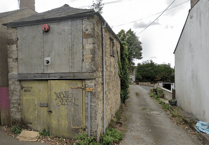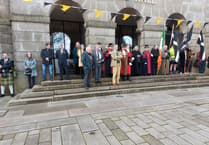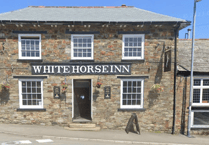LOCAL newspaper correspondent Audrey Miller was at the opening of the Tamar Road Bridge on October 24, 1961. Here she recalls the grand event as the Bridge celebrates its Diamond Anniversary.
In 1959, just a hundred years after the opening of Brunel’s Royal Albert Bridge in 1859, work began on the building of the Tamar Bridge.
This was quite an upheaval for Saltash as buildings near the site were demolished and lorries loaded with earth to be taken away caused mud along the nearby roads for the next two years!
Saltash residents watched the building with interest from the time the foundations were laid in the river, to the erection of the pillars and the hoisting of the sections of the roadway from a boat midstream in the river. This operation always attracted many spectators.
Mourning
During the building of the bridge, on Sunday, April 24, 1960, although it was a lovely day, a tragedy occurred when a boat, taking the workmen who were ending their shift, from the middle of the bridge to the shore was hit by choppy conditions and the waves swamped the boat, which capsized and the men were thrown into the water.
People in the ferry queue, and on Saltash ferry, witnessed the scene with horror, and several rescue boats quickly went out to rescue the men. Ten were rescued, two of whom were taken to St Barnabas Hospital, others taken to their homes. Sadly, four were drowned and one died after being rescued.
It was indeed a very sad day. It is believed that a smaller launch was used instead of the normal craft, which was being repaired.
The following day the men working on the bridge stopped work at 10am and observed the day as one of mourning in tribute to their five colleagues.
* * *
IN 1961, when the main structure was in place with a catwalk up to the top of the pillars and across the river, as a part-time correspondent for the local paper [Cornish Times] I applied to go up on the bridge.
“No women allowed on the catwalk,” was the reply. After making three applications, I received permission to go up with a party of 24 men, members of the local Toc H group.
In August 1961, dressed in trousers and a warm jacket, I met the group at the Saltash end of the nearly completed bridge, none of us wearing any safety equipment. Even the people building the bridge were not wearing safety equipment.
We were taken around by Mr R.D. Wootton, one of the consulting engineers, first to the foundations, then on the steep ascent on the catwalk to the top. My hands were covered in thick black grease with holding on to the cables too tightly!
The view from the top, 240 feet above the river, was wonderful and I regretted not having a camera with me. The descent was a little more difficult.
“Do not look down at the river and do not look up at the clouds,” said Mr Wootton, so following instructions we went slithering down on the wire mesh, where every few feet wooden batons stopped us slipping. We arrived safely on the ground.
The Toc H members included a member of St John Ambulance and two undertakers. Fortunately we did not need their services!
With the talk of a possible airport being built in the Trematon area of Saltash, and the nearly completed road bridge, I wanted to find out the aeroplane experts’ opinion, so I had my first flight from Roborough airport, Plymouth, in September 1961, in a four-seater Auster aircraft with the pilot and two young men having their first flying lesson! The flight lasted all of 15 minutes and went over Saltash and the bridges, with them looking like matchstick models from that height.
On us reaching the ground, the airport manager, Mr Lucas. said Saltash would be suitable to have an airport, and with the new gateway to Cornwall, the Tamar Bridge, it would be fine. That airport idea never materialised.
On October 23, 1961, I was a passenger on the last Saltash ferry at 11pm from the Cornish side, crossing the Tamar to Devon, then leaving at 11.15pm on the trip back to Saltash. Quite a party on board – with handbell ringers, an accordion playing, hooters on the river, and car horns sounding – ended 600 years of the Saltash ferry.
I remembered earlier days, as with other young teenagers I often spent an afternoon on the ferry, sitting on the top deck watching the cars driving on an off, and the activity on the river.
As long as we were well behaved, we were able to stay on board – no one ever caused any trouble.
But with the bridge opening so ended the ferry queues which, on the Saltash side, often stretched as far as Burraton.
Breathless
The next morning after the last ferry ran, in the rain at about 6.30am, I joined many others on a first walk across the completed Tamar Bridge, the new Gateway to Cornwall.
On April 26, 1962, Her Majesty Queen Elizabeth, the Queen Mother officially opened the Tamar Bridge. After cutting the tape, she decided to drive to Saltash Guildhall, not walk, so the Mayor, Alderman Maurice Huggins, and Town Clerk, Mr Gordon Bellingham, had to follow on, running behind. On reaching Saltash Guildhall, the Queen Mother was received by the caretaker, Mr Jerrard, who seeing her arrive unexpectedly by car, said: “I think Your Majesty is expected in the Mayor’s parlour”, and she was met by the wives of the Mayor and Town Clerk.
The Queen Mother said to them: “I’m afraid we have left your husbands behind.” Mr Jerrard had saved the day. The Mayor and Town Clerk arrived breathless later!
On April 26, 2002, Her Royal Highness Princess Anne unveiled a plaque to mark the strengthening and widening of the Tamar Bridge, exactly 40 years to the day after her grandmother, Queen Elizabeth, the Queen Mother, had officially opened the bridge. Taking photographs of royal events was a problem... NOT because of the royal guests but because of the paparazzi, with their large cameras, pushing me bodily out of the way to take their photographs, while I only had a small camera.
I hope that at a future royal event I will not be pushed out of the way!
My next occasion with the Tamar Bridge was on March 22, 2006, when at the age of 76, with the permission of David List, Manager of the Tamar Bridge and Torpoint Ferry Authority, I climbed inside the pillar on the Devon side.
I was accompanied by engineer Richard Cole and supplied with safety equipment, helmet, safety harness, rail-locking device, non-slip gloves, and fluorescent jacket, all weighing several pounds.
The ascent took me half an hour climbing straight up on a series of ladders. I had two small cameras on this occasion, so was able to capture the wonderful views from the top and appreciate this exceptional modern engineering project.
* * *
Yes, the Tamar Bridge is an asset to Cornwall and to Saltash but obviously has changed the town considerably.
Saltash, before the bridge, was a flourishing market town with plenty of shops in Fore Street – in fact, we had six butchers, whereas now we have one.
There were clothes and furniture shops, groceries, greengrocers, a fresh fish shop, newsagents, bookshops, stationers, bakers, cafes, dairies, chemists, ironmongers, radio and tv shops, cycle shops, and electric and gas show rooms. You name them, we had them all. Now most of those have gone, and supermarkets have taken their place but out at Carkeel, which is very sad and not so convenient, especially without a car.
Walking through the town, you knew everyone, but with the coming of the Tamar Bridge, the population and housing has increased, so this has obviously changed.
Before the bridge, public transport included buses supplying a service to outlying villages and towns, and there was the train service across the Royal Albert Bridge and Saltash Ferry across the river, but no bus service down to the ferry – you had to walk. There were taxis, of course.
Privilege
The advantages of the Tamar Bridge include easier access to Devon and beyond, 24 hours a day, and with public transport crossing frequently, and of course you can walk across.
Before the bridge, if you missed the last train from North Road Station, Plymouth, at 11.10pm you could not possibly catch the last ferry, which left Saltash Passage, St Budeaux, at 11.15pm, as you could not reach the ferry in five minutes.
Some people walked across the Royal Albert Bridge, which was not allowed. I made sure I did not miss the last train.
The Tamar Bridge has played an important part in my life and I have had the privilege of being allowed to climb up and learn all about the structure, care and maintenance of this modern-day wonder in Saltash where I have lived for many years, and see the bridge each day.
So here’s celebrating the 60 years of the Tamar Bridge as the Gateway to Cornwall.
It has been used by thousands of people and I trust it will serve us all for another 60 years or more, thanks to the modern technology of engineering and the care of those who built the bridge.




